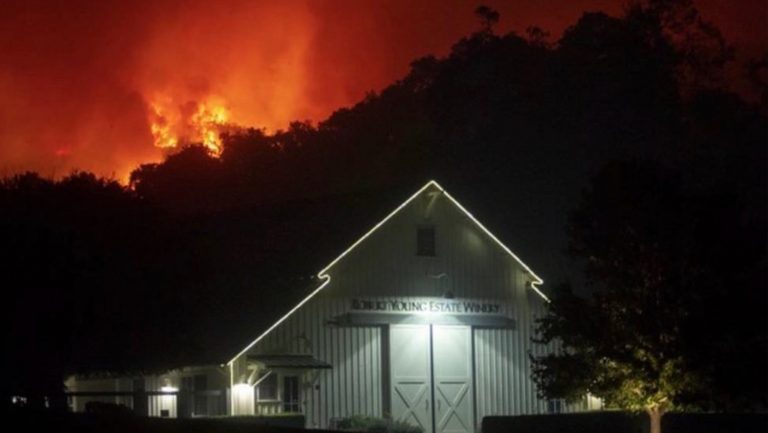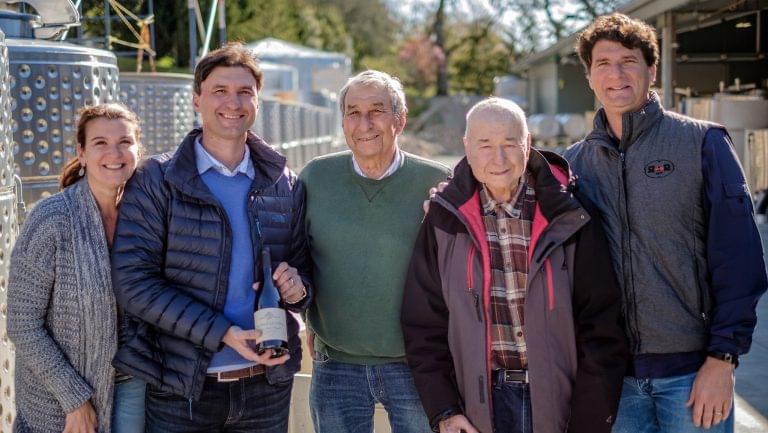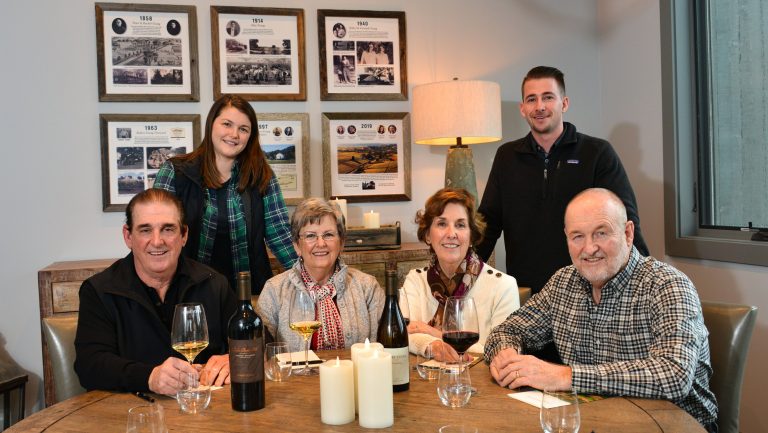In a tasting room overlooking their Sonoma vineyards, the siblings who own the Robert Young Family Winery were finishing each other’s sentences.
Susan: “They’re all welcome to sit in …”
Fred: “ … just not vote. But we listen to their opinions …”
Jim: “And we have a representative of the younger generation who does vote, Becky …”
JoAnn: “ … who’s Susan’s daughter. The next gens voted for her.”
They were talking about their board of directors, which balances the interests of business and family. It’s among the strategies the Youngs are using to secure their heritage—the 317 acres of vines the family owns, on the ranch where they were raised in the Alexander Valley. The fourth-generation descendants of an 1858 settler, they have no plans to leave.

Don’t miss the latest drinks industry news and insights. Sign up for our award-winning newsletters and get insider intel, resources, and trends delivered to your inbox every week.
“One of our claims to fame is that we’ve been here so long,” Fred Young, 66, told me. “There are few families in Sonoma that have been in the same spot for 160 years. Most have sold off.”
“Or,” added JoAnn, 78, “they keep the name and you think it’s still a family winery, but there’s another owner.”

It’s true: In a county of 1,800 wine growers, where 85 percent of vineyards are family owned, recent years have brought acquisition fever. Large entities like Gallo and Pernod Ricard have snatched up acreage, consolidating holdings that once belonged to several families. Although some buyers are families themselves—and not just the Gallos, but midsized growers who are expanding—with vineyards going for $100,000 an acre and viticultural costs increasing, the pressure to sell can be intense.
Sales bring wealth but can be painful. Says Ray Johnson, the executive director of the Wine Business Institute at Sonoma State University (SSU), “Grape growing is a passion, so farmers do what they can to keep land in the family and in agriculture.”
As the wave of growers that came of age in the 1970s retires, the question of how a family can sustain ownership is more relevant than ever. Where family farming is the paradigm, the culture of the region depends on growers’ ability to chart a way forward for their next of kin. It’s called succession planning, and in Sonoma it’s on everyone’s mind.
“Succession planning is critical to maintain the culture of family farming, with practices passed from one generation to the next, and love of the land that gives rise to stewardship,” says Karissa Kruse, the president of the Sonoma County Winegrowers association, which launched 10 months of seminars in 2016 to help growers plan the transition to the next generations. “Having a solid plan to ensure that the family farm stays in business in an increasingly complex regulatory, financial, and political environment is essential to the fabric of our community.”
It’s a process that requires equal parts commitment and creativity, as growers like the Youngs adapt the best practices of succession planning to the needs of their clans.
Get Advice and Make a Plan
Tim Wallace understands the stakes. He’s part of Sonoma’s Benziger family, which sold its business to The Wine Group, based in Livermore, in 2015 when the upcoming generation didn’t show interest in collaborating on ownership. “Instead of endowing it to some children rather than others,” says Wallace, “we decided to give them funds to go do other things.”
That’s a valid choice for some. What Wallace does now, though, as a consultant and an adjunct professor at SSU, is teach families interested in succession how to accomplish it. “The chance of getting to the second generation in a family business is about 30 percent,” he says. “Getting to the third generation—93 percent fail. It takes commitment to systemic thinking.”
To that end, Wallace poses numerous questions: Do you have an org chart? Are there written business plans? Do you have a means of making decisions and resolving conflict? What are the criteria for a child to join the business? Is there a sense of who will be the next managing leader?
The Youngs have been working on those questions for decades, getting help from consultants including Carolyn Coleman Bailey, a Gallo family member. Still, they feel they got a late start. Fred and Jim were farming with their father, and Susan and JoAnn were raising families off-ranch, when the siblings formed a family limited partnership in the mid-1990s. “Fred was going to inherit part of the ranch, and so was I,” says Jim. “Susan and JoAnn were going to inherit money or something else. So Fred and I put our property into the pot, and everybody got equal shares.” Having seen ranches lost following divorces and other life changes, the Youngs were solidifying family control.
Around the same time, the siblings launched a winery to vinify a portion of their grapes. “I convinced everyone it would be a good thing to give to our kids because we can’t all be tractor drivers,” says Fred. “They could be winemakers or do marketing—or a thousand things you can do with a winery.”
Susan and JoAnn took positions in the tasting room. But integrating the next generation into the business wasn’t easy. “Our kids had started their own families,” says Susan. “They loved the place, but they weren’t working here.”
The siblings started gifting portions of their shares, with attendant dividends, to their children as incentives to keep them interested in land ownership. But without the kids’ involvement in the business itself, it would be difficult to keep the ranch intact as the number of shareholders grew with the generations. “So we gathered the kids,” Susan says. “We asked them, ‘What do you want to do? If we sell, you can make big bucks, but you’re not going to ever have this again. If we keep it, we have to get the next generation trained up and involved.’”

That was in 2005. Today, Fred’s son, Robbie, an SSU wine business grad, heads up winery hospitality, and JoAnn’s granddaughter, Rachel Taylor, an enology student at the University of California at Davis, works in the cellar. They sit in on board meetings, learning the ropes while the older generation and a few consultants vote. “We call them BITs—board members in training,” says Fred. “Sooner or later, one will take over my position.”
Communication Is Key
The Youngs’ 2005 gathering was the launch of something that consultants say helps smooth kinks in succession plans. It’s called a family council, and unlike a board of directors, it gives each member a say “not in the business, but in the business of the family,” says Wallace. “Family is an emotional entity, and business is an economic entity. When they conflict, that’s the seed corn of trouble. So you have to diagnose the family dynamic”—and work through it toward an agreed-on future.
The family council is a structure for that. The Youngs spun theirs as vacations. “We had retreats in the mountains or at the coast, for building relationships,” says JoAnn. “We were trying to tell [the children] about the business, so Jim would give a presentation. And we’d make it fun with activities for the kids.”
The meetings shored up generational unity. When I met with the Youngs, they were anticipating their upcoming ranch day, an event for wine club members that all 30 of the Young clan attend. That illustrates a point about succession: Family is a powerful marketing tool. “Consumers will say they prefer to buy from a family business,” says Wallace, “from someone who wanted to do it, who loves it, who shares it with family.”
And if someone wants out? The Youngs’ buy-out agreement allows family members to sell only to other blood relatives. “It’s come up at recent board meetings that we should create a fund for that,” says Jim—buy-outs cost money. But the possibility of a buy-out is slim. Succession planning has accustomed everyone to the bottom line, which JoAnn describes as “We’re not going anywhere, so you gotta work with these people.”

Prepare the Heirs
The next-gen commitment to the family business was evident recently during the Kincaid fire that swept through the Young ranch, threatening the winery and historic buildings in late October following the harvest. As the flames approached, Robbie, along with Fred and Jim, refused the evacuation order and remained on the property to fight back the flames alongside first-responders.
“The family was very proud that Robbie stepped up during the fires, and stayed to help save the ranch, but we weren’t surprised,” says Robbie’s father, Fred. “What we’ve tried to do as a family is to instill a work ethic, a pride of ownership and a sense of responsibility in the younger generation. If you are successful with that, then they have a desire to keep the ranch together, to make it better and pass it on, so the family doesn’t lose what they have built, and it continues for another 160 years.”
In other words, it’s a matter of a shared culture. “Does the family have core values that engender trust and mutual respect and champion communication?” asks Wallace. “Like any team, you have to have a collaborative culture. You can teach that.”
Fifth-generation farmer Steve Dutton has done just that. He grows 1,200 acres of grapes with his brother, Joe, and between them, they have five children, aged 18 to 25. “Since our kids have been little, we told them, ‘Don’t ever sell the land,’” says Dutton. Though the kids “get it, for sure,” to drive the point home, he plans to sit them down with his mother, Gail, the family matriarch. “It’s important for them to hear directly from her what her wishes are: ‘I want you to get along, all keep the property, and figure out how to make this work.’ That will help them because they have respect for their grandmother.”
But you also need heirs to learn the financial and logistical ropes. “If you plan to turn over the reins at some point, you can’t just drop it on them when you’re gone,” says Santa Rosa trust and estates lawyer Katherine L. Jeffrey. “You have to bring them up and make them understand the business.”
Lee Martinelli’s great-grandparents settled in the Russian River Valley in the 1880s. Today, Martinelli, 54, and his younger brother, George, farm 450 acres of grapes and 75 acres of apples alongside their father. Their sisters, Julianna and Regina, work in sales and marketing for the family winery that uses a portion of their grapes. Some vineyards are owned by individual siblings, “so if you want to do your own thing, you have the opportunity,” Martinelli says. The heritage plots, planted by Martinelli’s grandfather, are owned by the family in trust.
The Martinellis are thinking about the next leaders. “Julie’s daughter Tess works for Benziger, so she could be somebody to take over,” Martinelli told me as we sat in the winery beneath ancestral portraits. “We would like for the next generation to get three years’ experience working in the industry for some of our peers.”
Such experience is key for succession’s managers-in-waiting, says Wallace. “[Those people have] to earn it just like they would in the business,” he says, “and you want [them] to acquire the skills.”
What happens if there are no successors among the kids? First-generation Sonoma farmer Duff Bevill and his wife, Nancy, own 120 acres. Bevill also runs a vineyard management company that services his and other vineyards. At 69, he’s winding down. With his children unwilling or unable to farm, he’s had to find a business heir elsewhere. “Who’s going to take care of my ranches?” he says. “I don’t want to sell all the properties. It made sense to bring in somebody who had been working for us. There’s an opportunity to create a succession plan but also reward dedicated employees.”
Bevill made a member of his team a partner with a “You killed it, you eat it” path to ownership: Bring in new clients, and when they reach a certain dollar amount and are retained for a certain number of years, those clients earn you a percentage share in Bevill Vineyard Management. For the care of his land, Bevill says “the idea is that continuity is valuable.”

The Next Wave of Sustainability in Wine
Winemakers discuss three ways to take environmental efforts to new heights
Sustainability and Succession Go Hand in Hand
Bevill is known as Sonoma’s godfather of sustainability for his work with clients in optimizing vineyards for certification. Across the county, farmers like him are committing to a program of sustainability headed by Kruse’s Sonoma County Winegrowers. It’s a wraparound program that includes labor practices, land stewardship, and crucially, planning for future generations.
“At the heart of succession planning and the future of local farming is sustainability,” says Kruse. “Succession planning is included in the 140-plus best practices that growers follow as part of their SCW sustainability certification.”
An example is the Sangiacomo clan. Steve Sangiacomo’s grandfather founded one of California’s largest family-owned pear farms. By the 1960s, when Steve’s father and uncles were running things, canneries were closing. “They had 300 acres of pear trees, and they pulled them all out,” Sangiacomo says. “They sold their canning rights, mortgaged the ranches, and went into grapes.”

The bet paid off. Today, Sangiacomo, his brother, and his brother-in-law manage 1,600 sustainably certified acres of vineyards. The older generation’s foresight taught Sangiacomo that “a multigenerational business has to be successful to begin with or you have nothing to pass down.”
That’s economic sustainability, an aspect of which is the affordability of land transfer. “Our grandparents set the example,” says Sangiacomo. “They were proactive estate planning–wise so that it stays in the family and there’s not a huge tax burden. They were able to pass it on, and the second generation passed it on to us, and we’re slowly trying to pass it on to not have a big tax hit to the next generation.”
The clock is ticking. The record-high federal estate and gift tax limit that allows individuals to leave as much as $11.4 million to heirs tax-free is set to expire in 2026. If there’s a new administration in 2020, that deadline could come even sooner. “If you have property in excess of that amount, or the appreciation of your grape-growing land may put you there eventually,” says Jeffrey, “you should take advantage of this higher-exemption environment.”
The Sangiacomos are also concerned with ecological sustainability. “Climate change has put a hyper-focus on what we’re doing, which makes us better stewards of the land,” Sangiacomo says. That role is crucial to succession, too—as Sangiacomo says, “Our vineyards are like family heirlooms. They all have a story, an emotional connection. You feel pressure to leave the family business in a better state than you received it. You gotta make strategic decisions and hope for the best.”

Opportunities for Growth
As next-gen farmers come to the fore, they’re seeing opportunities in neighbors’ inability to plan strategically. In an environment where small landowners struggle with the costs of farming, there’s room for growth on aging neighbors’ land. Bret Munselle’s family has farmed in the Alexander Valley since the 1870s, but when his father told him there wasn’t a role for him on the 150-acre family vineyard, Munselle became an appraiser for crop loans instead. His experience in assessing properties has proven invaluable now that he is finally farming with his father. The Munselles’ holdings have grown to 300 acres, and they farm 400 additional acres for clients.
“There are not a lot of 30- or 40-year-olds in our industry,” says Munselle. “There are properties owned by 80-year-olds who don’t want to sell but can’t farm them themselves, so there’s opportunity for me to help neighbors and eventually farm for them. It’s great for my career, and it’s nice to feel like you’re working with friends you’ve known forever.”
When younger generations find their own opportunities, it also relieves stresses involved in succession. Mark Sanchietti, 35, is the fourth generation of the Sonoma County Farm Bureau’s 2019 Farm Family of the Year. He and his father work 400 acres that they own, lease, or manage. While the family is still working out the details of their succession plan, he’s been acquiring his own vineyards and running his own management company since he graduated from college. “My folks have stuff; my wife and I have stuff,” he says. “It’s very clean.”
As Sanchietti sees it, his mix of family farming and independent ownership is a good formula for his future. It’s a way of diversifying, of not putting all his eggs in the family basket. “I have a friend,” he says, “who was a dairy major. His dad called and said, ‘We sold all the cows.’ He was devastated. I couldn’t imagine hearing that.”
Ultimately, succession planning is an increasingly complex process. As Munselle puts it, part of being a successful family grape grower these days is understanding how the context has changed. His grandfather, he says, believed that “if you weren’t driving tractors, you weren’t working.” Today, in contrast, “you have to acknowledge that you’re a businessperson, not just a tractor driver.”

Dispatch
Sign up for our award-winning newsletter
Don’t miss the latest drinks industry news and insights—delivered to your inbox every week.
Betsy Andrews is an award-winning journalist and poet. Her latest book is Crowded. Her writing can be found at betsyandrews.contently.com.






